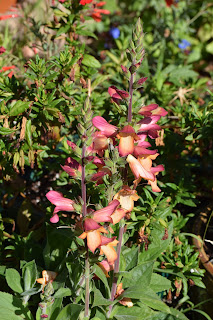So, here it is, in its unvarnished glory. Hope it's helpful!
4 Kinds of Shade
- Full morning sun (MS)
- Two to three hours of morning sun (PS)
- No direct sun but bright shade (BS)
- Dark shade (DS)
Oakland Shade vs Fresno
Shade
Interpreting
what books say about shade or sun depending on where you live.
Adjusting up ½ a sun factor for the milder zones.
The
list below is divided into groups per type of plant. They are
designated by the most amount of shade they will prosper in. Thus, a
plant designated BS (for bright shade) will also handle PS and MS
unless noted. Selections with a CN
are California natives. All plants listed are perennial with the
exception of Nicotiana, which often reseeds.
Planting Shade
Perennials
- Planting by season.
- Watering to establish then cutting back.
- Mulching to save water
- Slugs & snails. More prevalent in shady areas. Treatments.
- Deer. Most of the selections here are either deer proof or will discourage them.
- Maintaining shady areas. When to cut back. When to remove.
Shrubs (Planting
foundation plants first)
Plectranthus
(BS) – best plant for shade, all heights, leaf textures
Arctostaphylos
(BS) CN – good foundation plant; RPBG selections
Sarcococca
(DS) – Winter box offers fragrant late winter flowers, handles deep
shade
Mahonia
(BS) CN – tough & durable, yellow flowers, all sizes
Perennials (For adding
texture and color)
Francoa
(PS) – tough, clumps out, summer bloomer
Hellebores
(BS) – cut back foliage to ground in late fall; treating white
flies
Heuchera
maxima (BS) CN – year round appeal, largest Coral bells
Nicotianas
(PS) – many different types, colors, heights, fragrant
Ground covers (For
filling in bare spots or as a natural weed control)
Asarum
caudatum (BS) CN – tough, heart-shaped shiny leaves, curious
flowers
Rubus
(BS) – rough textured leaves, tenacious, beautiful, prostrate
Ajuga
(PS) – light or dark leaves, establishes easily, wants a little
water
Geranium
Rozanne (PS) – one of many true geraniums that spreads, showy
flowers
Tellima
grandiflora (BS) CN – charming heuchera-like flowers, stays
neat
Epimedium
(BS) – tenacious, 1-2' tall, charming small flowers of different
colors
Ferns (There are
several choices for adding that special look that only ferns give)
Leatherleaf
fern (Rumohra adiantiformis) (BS) – survives dry spells but better
with H2O
Western
Sword fern (Polystichum munitum) (BS) CN –
one of our toughest ferns!
Grasses (Good choices
for areas that get light traffic)
Carex
pansa (MS) – tough evergreen grass that can even handle light foot
traffic
Ophiopogon
planiscapus (BS) – black mondo grass, provides great color,
adaptable
Succulents (Succulents
go well with grasses or phormiums)
Aeoniums
(BS) – large leaves, some colorful, prefers some shade; frost
damage
Sedum
Angelina (PS) – fast spreading ground cover; more golden in sun
Phormiums/Cordylines
(PS) – tough plants for adding leaf texture and color
Vines (Though most
popular vines like sun there are plenty for shade)
Jasminum
Pepita (PS) – smaller variety of pink jasmine, fragrant,
establishes easily
Solanum
Navidad (PS) – one of the showiest potato vines (purple flowers),
tenacious
Bulbs (Though not as
well known there are bulbs that prefer a bit of shade)
Brodiaea
'Rudy' (MS) CN – naturalizes easily, purple flowers, early
summer blooms
Iris
douglasiana (BS) CN – most resilient of all irises, spring
bloom, colonizes
Iris
confusa (BS) – pretty white or lavender (Chengdu) flowers, sun or
shade, any soil











































